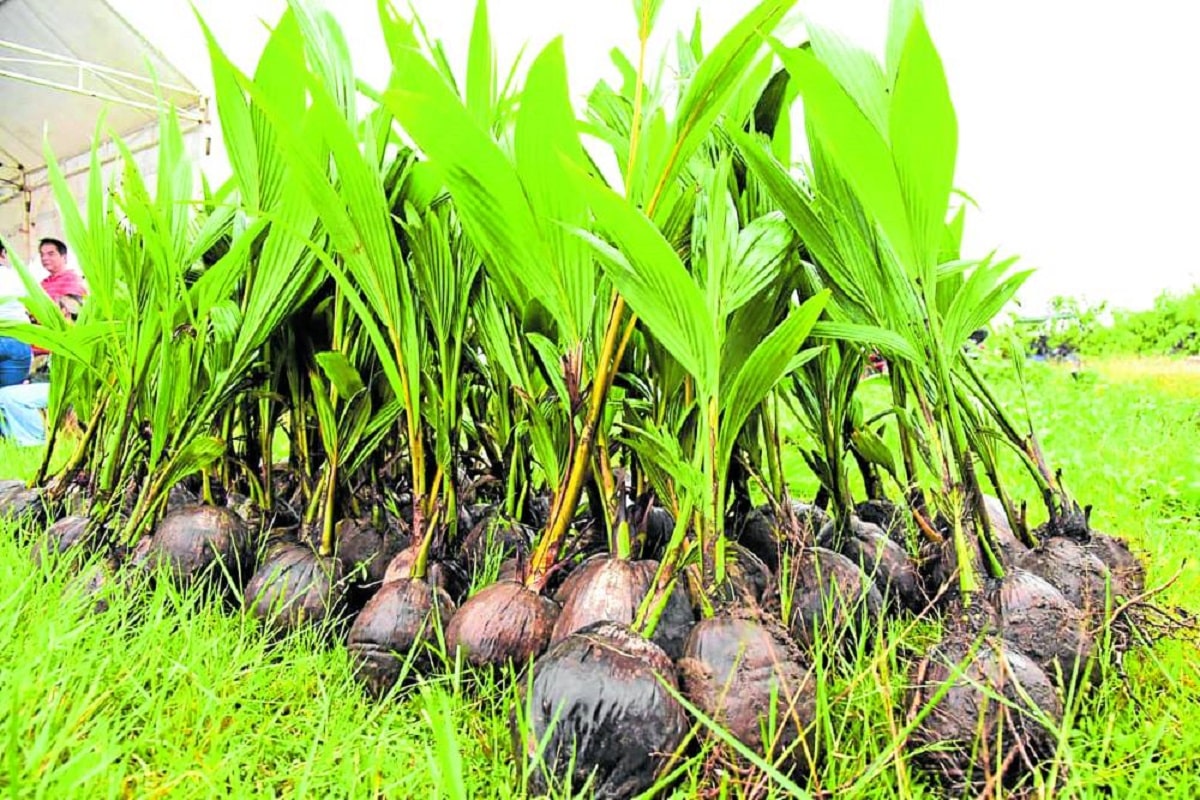Marcos okays additional P3.5B for coconut propagation

FOR REVIVAL The Philippines used to be the world’s top producer of coconuts, but it now just ranks second, after Indonesia, as the sector fell into years of neglect. Photo taken at a Philippine Coconut Authority event in Lingayen, Pangasinan, on Thursday. —Pangasinan Provincial Government Facebook photo
MANILA, Philippines — President Marcos has approved an additional P3.5 billion for the coconut planting, replanting and fertilization program next year to support efforts to improve the sector and enable the country to reclaim its position as the world’s top producer of the commodity.
In a meeting with officials of the Philippine Coconut Authority (PCA) in Malacañang on Tuesday, Marcos instructed them to do “whatever is necessary” to improve the production and export of coconuts.
“I have instructed the government agencies central to our coconut industry to do whatever is necessary to reclaim our position as the top producer of coconuts and maintain our status as the leading global exporter. This directive includes the development of the entire value chain and a clear timeline to achieve these objectives,” the President said on his social media accounts.
READ: Philippine Coconut Authority seeks higher budget of P2.4B in 2025
In a statement, the Presidential Communications Office said Marcos approved an additional P1 billion for the PCA’s massive planting and replanting of coconuts, and P 2.5 billion for its fertilization plan for 2025.
Article continues after this advertisementPCA Administrator Dexter Buted informed the Chief Executive that this additional funding would allow the government agency to plant 15.3 million coconut trees next year.
Article continues after this advertisement100M palm trees until 2028
The PCA, noting that the last time the Philippines implemented a massive coconut planting program was 40 years ago, launched last year the 10-year Philippine Coconut Industry Development Plan (PCIDP) to address the myriad problems affecting the sector, particularly aging coconut palm trees, pests, and diseases, poor farming methods and destruction caused by natural calamities.
Under the plan, the government set a goal of planting 100 million coconut palm trees until 2028, or by the end of the Marcos administration, and proposed a P102.02-billion budget for its 10-year implementation.
The 100 million coconut seedlings will be planted across 700,000 hectares of land to increase the Philippines’ coconut production by 4.7 billion coconuts, which will be worth P33.1 billion by 2034.
For this year, the PCA is targeting to plant 8.5 million coconut seedlings, followed by 15.3 million coconut seedlings in 2025 and 25.4 million coconut seedlings annually from 2026 to 2028.
The Philippines used to be the world’s top producer of coconuts but slid to second place following years of neglect of the sector.
From 15.86 million metric tons of coconut in 2012, coconut production in the country fell to 13.83 million MT in 2016 before rising to 14.73 million MT in 2018 and 14.93 million MT in 2022, according to the PCA.
While Indonesia is now the top producer of coconuts, producing an average of 17.06 million MT of coconuts from 2017 to 2022, the Philippines is still the world’s top exporter of coconuts and accounted for $3.22 billion, or 43 percent, of the country’s total agriculture exports in 2022.
The Philippines has a total area of 3.6 million hectares planted with coconut palm trees or about 27 percent of total agricultural land. It has 340.6 million coconut-bearing palm trees capable of producing 14 billion to 15 billion nuts annually.
Big export market
During Tuesday’s meeting, the President stressed the importance of increasing efforts in planting coconut seedlings given the coconut industry’s potential.
“We still maintain our very high position in terms of coconut products exports, despite the fact that we have neglected the coconut industry for so many years. We’re still number one despite the fact that we are really working with very limited raw materials because we haven’t replanted. Our trees are old,” Marcos said.
He added: “That’s why I’m focusing on the production side and that’s what we have to increase. The critical part of that is the replanting.”
The Chief Executive said there is a big market for coconut products and that the industry has not yet reached the market’s “large and growing” limit or demand for coconut products.
The President also ordered the PCA to work with the Cooperative Development Authority to consolidate farmers’ groups and associations to enable them to implement the massive planting and replanting program.
The Department of Agriculture, for its part, vowed to implement intercropping of coffee, cacao and bananas while coconut farmers are waiting for their coconut seedlings to grow into trees and become productive.